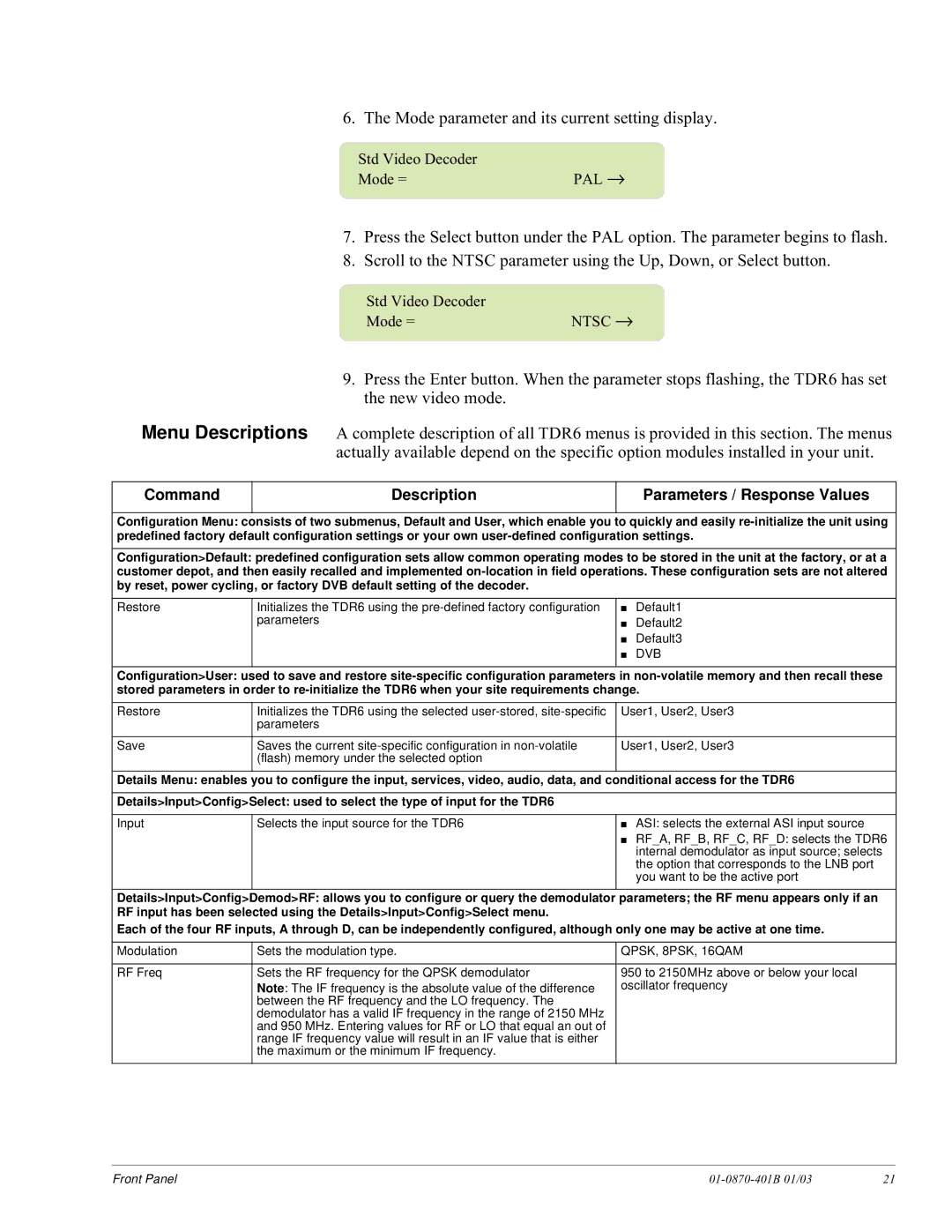
6. The Mode parameter and its current setting display.
Std Video Decoder | PAL → |
Mode = |
7.Press the Select button under the PAL option. The parameter begins to flash.
8.Scroll to the NTSC parameter using the Up, Down, or Select button.
Std Video Decoder | NTSC → |
Mode = |
9. Press the Enter button. When the parameter stops flashing, the TDR6 has set the new video mode.
Menu Descriptions A complete description of all TDR6 menus is provided in this section. The menus actually available depend on the specific option modules installed in your unit.
Command | Description | Parameters / Response Values |
|
|
|
Configuration Menu: consists of two submenus, Default and User, which enable you to quickly and easily
Configuration>Default: predefined configuration sets allow common operating modes to be stored in the unit at the factory, or at a customer depot, and then easily recalled and implemented
Restore | Initializes the TDR6 using the | ■ | Default1 |
| parameters | ■ | Default2 |
|
| ■ | Default3 |
|
| ■ | DVB |
|
|
|
|
Configuration>User: used to save and restore
Restore | Initializes the TDR6 using the selected | User1, User2, User3 |
| parameters |
|
|
|
|
Save | Saves the current | User1, User2, User3 |
| (flash) memory under the selected option |
|
|
|
|
Details Menu: enables you to configure the input, services, video, audio, data, and conditional access for the TDR6 | ||
|
| |
Details>Input>Config>Select: used to select the type of input for the TDR6 |
| |
|
|
|
Input | Selects the input source for the TDR6 | ■ ASI: selects the external ASI input source |
|
| ■ RF_A, RF_B, RF_C, RF_D: selects the TDR6 |
|
| internal demodulator as input source; selects |
|
| the option that corresponds to the LNB port |
|
| you want to be the active port |
|
|
|
Details>Input>Config>Demod>RF: allows you to configure or query the demodulator parameters; the RF menu appears only if an RF input has been selected using the Details>Input>Config>Select menu.
Each of the four RF inputs, A through D, can be independently configured, although only one may be active at one time.
Modulation | Sets the modulation type. | QPSK, 8PSK, 16QAM |
|
|
|
RF Freq | Sets the RF frequency for the QPSK demodulator | 950 to 2150MHz above or below your local |
| Note: The IF frequency is the absolute value of the difference | oscillator frequency |
| between the RF frequency and the LO frequency. The |
|
| demodulator has a valid IF frequency in the range of 2150 MHz |
|
| and 950 MHz. Entering values for RF or LO that equal an out of |
|
| range IF frequency value will result in an IF value that is either |
|
| the maximum or the minimum IF frequency. |
|
|
|
|
Front Panel |
| 21 |
